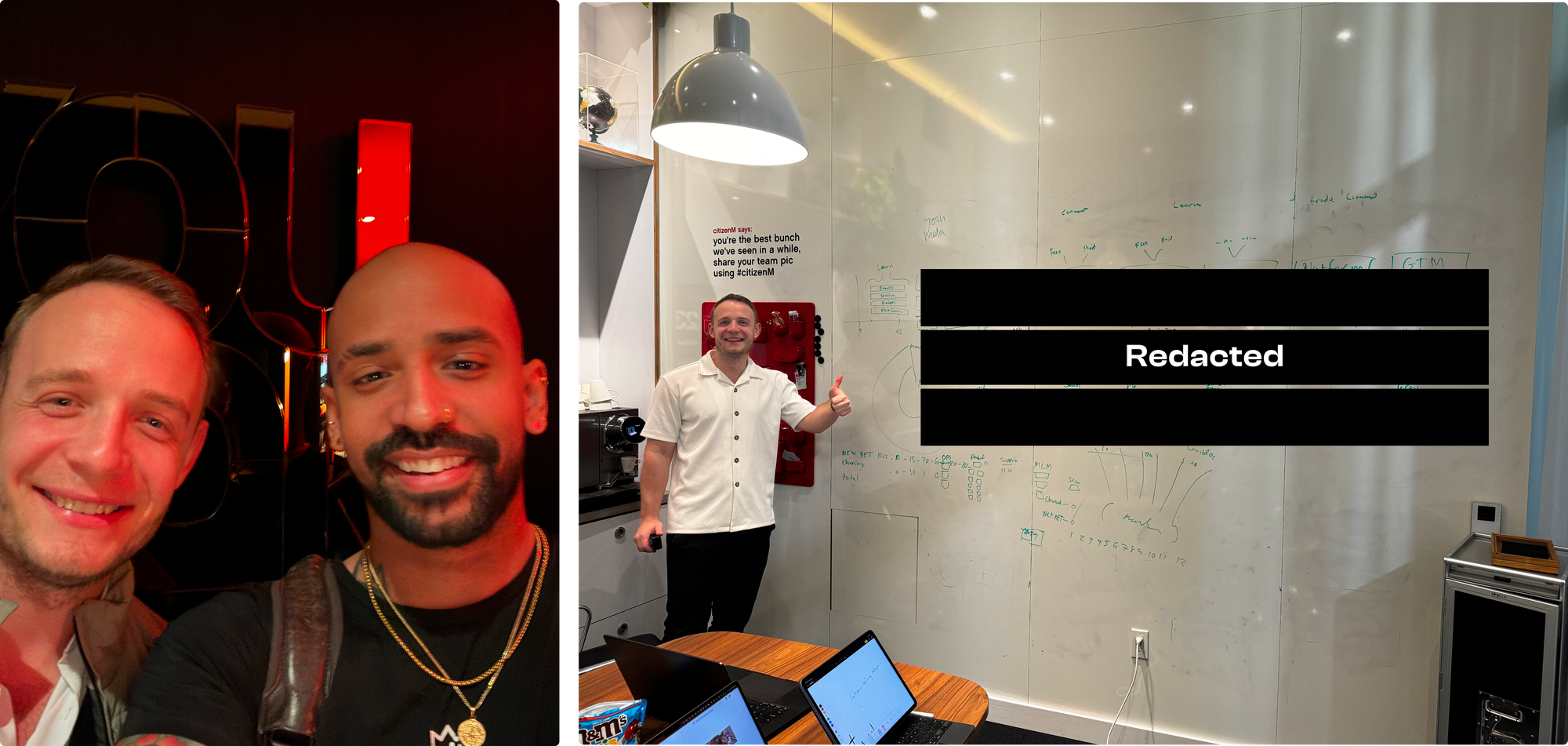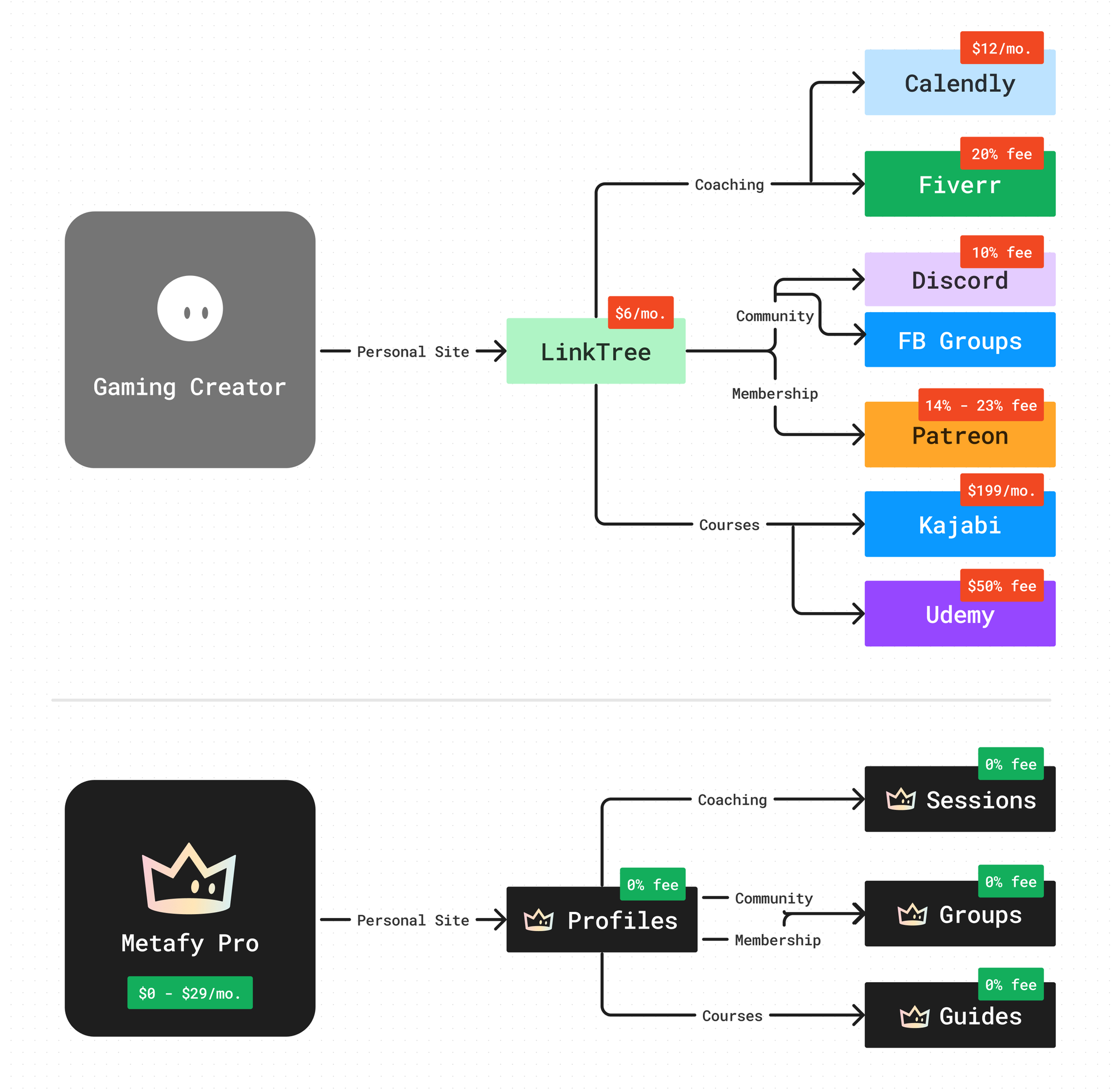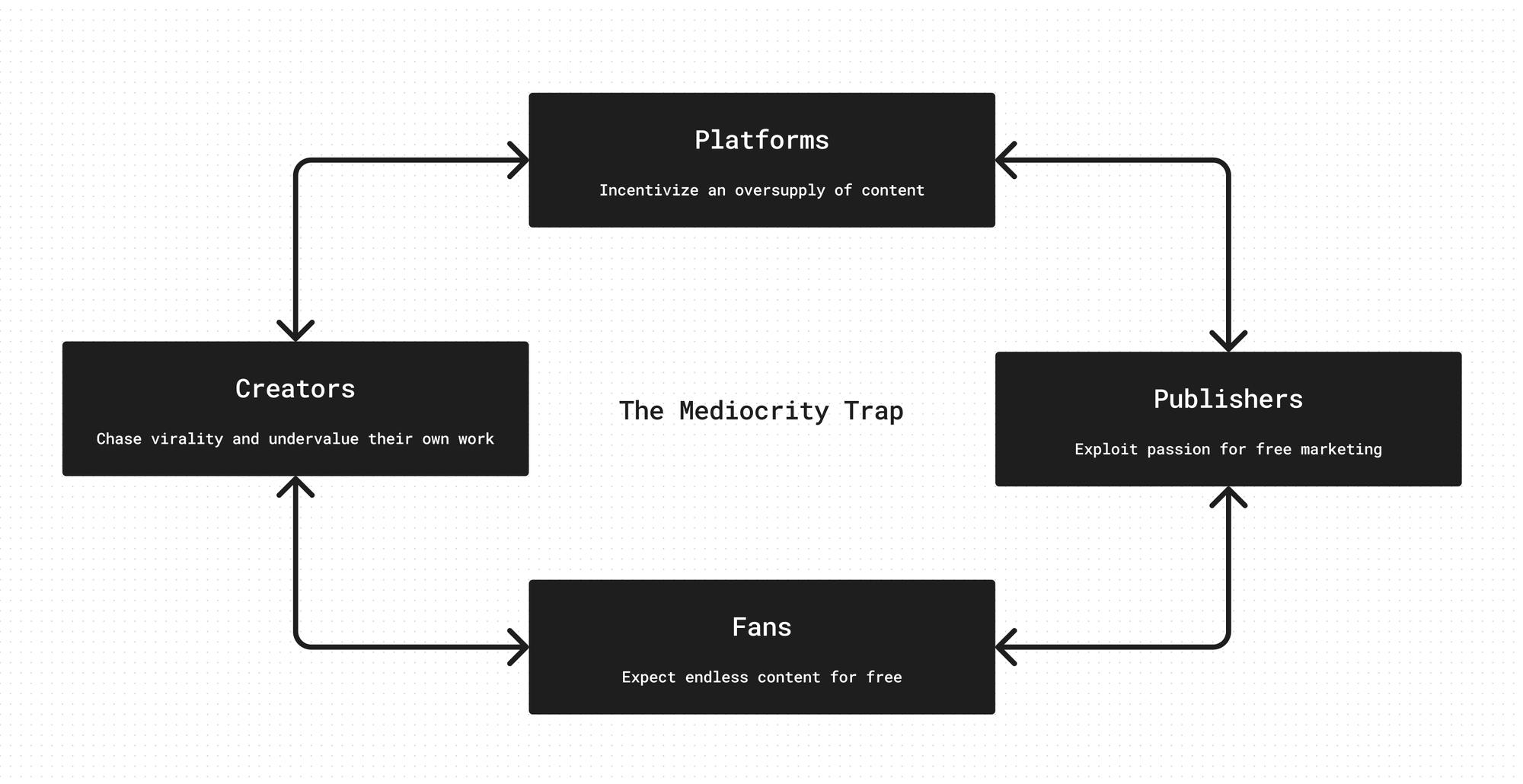
The Mediocrity Trap
Dear Investors,
One of my many toxic traits is that I'm very much a closeted hustle bro. Those cringe videos with titles like "how bad do you want it?" get me going.
Sometimes I listen to them while I take a cold shower. It makes me feel like a real alpha. I don't have a coffee cup that says "Hustle", but I'm one instagram ad away from it.
I've carried this shame in silence for far too long.
Buuuut, yesterday I ate an entire bag of Doritos for dinner (w/ Haribo Goldbear appetizer) - so this isn't going to be some Tony Robbins shit. He's a terrible human anyway. This is instead a bit of a recap of where we've been, and where we're going. It's all the rationale as to why I remain confident that Metafy will make a lot of you scoundrels richer.
Before we get into that, I'm afraid there's some background knowledge required. I want you to understand why the creator economy is broken by design, and why I suspect it won't stay that way. Give me a moment to bust out my fake internet PhD and explain.
Get comfortable, we're going long-form.
Aggregation Theory
Coined by the legend that is Ben Thompson, Aggregation Theory explains how platforms that get endless supply for fuck-all dominate industries via unparalleled distribution. It's why there isn't a lot of reason to use the second best e-commerce platform, or the second best social network.
He said it more eloquently, of course.
Thompson's theory is crucial to understanding why the creator economy is structured the way it is, and why platforms like Twitch and YouTube have become so dominant—and problematic—for creators.
Here's a video, because I know you're not going to read the article.
The 2021 Twitch earnings leak did a pants-shittingly good job of opening our eyes to how bleak it actually is for creators.
99.93% of streamers don't make a living wage.
25% of the top 0.1% don't even make minimum wage.
These stats are so absurd, so grotesquely fucking lopsided, that it would be comical if it weren't so damn dirty. The profit is gobbled up by the 60-year old executives making all the rules, but, that's nothing new.
YouTube isn't much better. TikTok is worse.
A tiny fraction of creators capture the majority of revenue, leaving the rest burnt out and broke. While my generation may not consider these real careers, our kids aspirations are being crushed under the weight of corporate greed and algorithmic indifference.
Said dramatically, Aggregation Theory is why we can't have nice things. But, it's not going anywhere - so what natural adaptation to it should we expect?
Niche Value Theory
When Tom and I started Metafy, four long years ago, it was because we believed that gamers could monetize their knowledge directly. We felt an obvious monetization pattern was showing up with a handful of savvy creators that could be productized to do what Twitch and YouTube seemingly couldn't by design.
We didn't originally call it Niche Value Theory. I just made that up to trick you into thinking I'm as smart as Ben Thompson is. The general idea is that in a world dominated by aggregators, like YouTube, significant value inevitably accrues to highly specialized providers who can offer depth, expertise, and personalized experiences.
Back then we explained it more as "people would definitely pay for this shit."
Here's the pattern we see emerge:
Expertise Differentiation: The generalists cast a wide net of shallow content, intended for a general audience. Deep expertise becomes a key differentiator for a community that wants to go deeper.
Direct User Relationships: Niche creators build strong, direct relationships with their users.
Focused Monetization: Niche audiences often have higher willingness to pay for specialized content or services.
Community Building: Niche experts foster engaged communities, creating network effects at a micro scale.
Niche Value Theory doesn't compete with aggregators on their terms. It instead surfaces as a viable model anywhere aggregation is found. The distribution power of aggregators becomes an organic funnel for capturing value through direct monetization.
Real-world applications
To simplify with an example, let's look to when Netflix's 'The Queen's Gambit' sparked a global chess revival. Chess.com saw 1M+ new accounts monthly, chess sales went up 1100%, Twitch viewership increased tenfold, etc.
Netflix drove people's interest, and niche creators and platforms captured the upside of that interest. This is happening, at a smaller scale, across countless niche communities, but there hasn't been a platform specifically designed to capture all of that upside.
We're doing that for gaming specifically. Each game is it's own hobbyist community, complete with it's own micro economy. This is how players without a huge audience, like Tord Reklev, can go from paltry sponsorships to making $7k in two hours on Metafy.
(Tord went on to break that record a few weeks later)
The Prototype
Metafy 1.0 was our proof of concept, and it wasn't without its missteps. We spent the better part of 2023 evolving from what the world knew as strictly a coaching platform to “Metafy 1.0”, a purpose built product to turn gamers into entrepreneurs. There was a significant period where we were spinning our wheels. As it turns out, solving culture defining problems isn't a linear process.
That said gamers have made $10M+ using our 1.0 prototype - primarily through coaching, our most robust offering. Hundreds of thousands of users have followed them to our platform.
We've found a repeatable formula for turning enthusiasts into entrepreneurs. We're creating a machine that actually turns passion into profit.
But it was also a mess of compromises, a confusing product that left too much on the table. We'd proven out some finer details to the problem, but the solution wasn't yet capable of, uh, solutioning... at least not at scale.
That was a job for "Metafy 2.0", a further refinement on the foundation we had built. That was the focus of our January leadership offsite.
I didn't expect it to come together so quickly...
Miami
We were here to plan out the year, and find a path to profitability. We stayed in the business district, which is a hellhole, so we ended up just camping out in the conference room of the citizenM hotel from morning until night for three days. We knew what we had with "Metafy 1.0" was pretty far off from being a real business.
It was a time for hard questions, hard liquor, and long-term thinking. That's when Victor asked a question I wasn't prepared to answer. As COO, those kind of questions are something of a specialty of his.
“If you had to compete against Metafy, how would you win?”
Like a good martini or a bad colonoscopy, it cut through all pretense. It’s the kind hypothetical we’ve tossed around in countless strategy sessions. But this time, something was different. Maybe it was the phrasing, the implicit acknowledgment that we were no longer the scrappy underdogs.

I didn’t sleep well that night. I don't sleep well most nights, but I slept extra-not-well that night. With terrible clarity, I saw every crack, every compromise, every corner we’ve allowed "good enough" to nest and breed. I knew more than I realized about where we were weak and how I competitor might go for our jugular like I had for those who came before us.
I won't be writing about what exactly those cracks, compromises and corners were in this letter. You'll have to buy me a drink, and maybe dinner, to see those scars.
Tom, Victor and I made the call the following morning. We wouldn't be slowly iterating towards Metafy 2.0, we were about to get sweaty. Metafy 2.0 would be a fairly exhaustive rewrite carefully crafted by hands now calloused with experience.
We aimed to rebuild what we had spent 3 years building in 2 months, and thanks to our absurdly talented team of misfits and miscreants, we pulled it off.
Our heads were down as the sky was seemingly falling around us. Gaming startups and esports teams are dying left and right. The creator economy had lost it's luster. AI was the new industry darling.
The opportunity felt more obvious now than it had ever been, and I'll tell you why.
"Josh, are you about to try and coin another term?" You bet your perfectly shaped ass (nice work!) that I am...
The Hobbyist Economy
The Creator Economy, at its core, is a manifestation of Aggregation Theory. If you watch the video about it above, and I know you didn't, you'd understand that platforms like YouTube, Tiktok and Twitch serve as aggregators, providing creators with unprecedented access to audiences while simultaneously commoditizing their content.
Unlike the winner-take-all dynamics of the Creator Economy, the Hobbyist Economy allows for a more distributed success model. Thousands of niche experts can thrive simultaneously within a community, each catering to their unique slice of the passion pie.
The hobbyist economy, at its core, is a manifestation of Niche Value Theory.
Here are the key assumptions:
Depth over breadth: Success is determined by depth of expertise or experience rather than the size of the audience.
Direct value exchange: Hobbyists monetize their skills directly, bypassing traditional content creation and sponsorship as a primary means of stacking paper.
Micro-community focus: Value is created within small, highly engaged communities. This happens today in places like Discord and Reddit.
Platform as enabler, not aggregator: Platforms in this economy connect experts with hobbyists, and hobbyists with deep communities. That's us.
Metafy as an enabler
I want you to think about how monetization happens today. Right now, if you're a gamer that's making real money, you're probably using Linktree for your bio, Fiverr for coaching, Udemy for courses, and Patreon for your community. That's four different platforms, four different logins, four different fee structures.
And then you've gotta string them together.
That's what the hell we're fixing.

The impact of AI
If our AGI overlords don't kill us off, we're going to have a lot more free time for the weird shit that makes us feel alive. We should see a virtuous cycle of abundance play out like this:
- AI automates routine tasks
- Human productivity skyrockets
- Economic output increases
- Working hours decrease
- Leisure time expands
- Demand for recreational activities grows
- New industries emerge to meet demand
- The hobbyist economy flourishes
Where it was once software, it's now AI that's eating the world. Whether you're willing to accept it or not, AI is going to take a helluva lot of jobs. I don't think it'll be as fluffy and fun as the tech bros like to imagine. Either way, what's true is that people are going to have a lot more time, and that free time is going to be spent in places of passion.
The Mediocrity Trap
Are you still with me? We've covered a lot today. It's time to close it out with the namesake of the letter, and our core problem to solve.
The creator economy, for all its promise, has a fundamental flaw. I call it the Mediocrity Trap. That's right, more made up terminology. This trap is a natural consequence of the perverse incentive structures in the current creator ecosystem.
To better understand how one gets caught in the trap, it may help to look at this hastily made chart. I'd include esports teams, but they've already mediocre'd themselves out of the equation.

This structure creates a self-reinforcing cycle that drives down the value of content and, by extension, the earnings of creators.
Escaping the trap
The product we're building with Metafy 2.0 is genuinely a work of art. An all-in-one platform providing a suite of tools for gaming creators to make an actual living doing what they love.
Each tool tightly integrated with the next to ensure that we're doing the heavy lifting of building a profitable business for creators, with multiple revenue streams tightly linked together. We've devised some clever systems to make building such a platform scalable with a small team.
I'll go into the intricacies of the product in a future letter. This is already longer than most will bother reading.
The challenge with creating an escape hatch out of the mediocrity trap is that problem is more than technical, it's behavioral and economic too.
It requires:
- Shifting creator mindsets from content producers to entrepreneurs.
- Retraining user expectations around the value of expertise.
- Building new infrastructure to support direct monetization at scale.
We've been hard at work on building infrastructure over the last couple years. We're now moving into a place of educating creators of their untapped potential.
The following video is a good indicator of what that change looks like in the early stages within a community.
Start from 9:00, unless you're really into Pokemon
It's controversial, and met with hesitation. I continue to find it shocking how few of gaming creators actually believe it's possible to make money, only to be themselves shocked when they do.
This is why building in public is important.
We're very early.
How it's going
In spite of those challenges, there are gamers on Metafy who will easily clear 6-figures this year with Metafy representing 80% - 90% of their overall earnings.
That's the hobbyist economy at work.
Creator earnings: $10,039,550
Premium Subs: 480
M1 Retention: 90% (too early for this to be accurate)
Cash on Hand: ~$7M+
Monthly Burn: ~$305k
Runway: 24+ months
Despite some strong early indicators, it's true that these numbers are not yet in a place where you could say the business is performing. We're fortunate to have the investors we do, they've given us the trust to continue executing against a very ambitious vision. We've made a number of hard decisions to ensure we have enough time to prove out this concept, and work to further create this category.
We'll know in a few years if we're brilliant or a buffoon. Or both. Probably both.
Pivoting the model
With the launch of Metafy 2.0, we introduced a subscription tier that removed the 20% fee we've been taking. This is a somewhat controversial shift, but I believe the category is in a place in which what's most valuable is not extracting the most value from each transaction, but in becoming the indispensable aggregator of interactions.
Call it a pivot, call it an evolution, the aim is ultimately about ensuring we're aligned with our users at all stages of their business - not just the beginning. Over the coming weeks and months, we'll continue fine-tuning our pricing. I also expect we'll release a few more pricing options to better serve the full community.
That's all, folks
It's been over a year since I last wrote to you all. And if all of the underwear I've been receiving in the mail is any indication, there's been a mutual missing of one another.
Or, I've got a subscription I forgot to cancel.
The truth is, these were never about me actually writing to my investors. Our investors have, of course, been getting private updates along the way.
The goal with these letters is not to show you how (very, very) smart I am, or seek validation pretending to be some bullshit startup guru. I'm still figuring it out the same as everyone else. The intention is sharing the journey, detours and all.
I expect to be wrong about much, like most who chase dreams and make bold claims. That's part of the adventure.
Nothing mediocre about that.
Until next time,
— Josh
P.S. I'd love to know how you felt about this issue of Letters to My Investors. I'd be happy to hear from you through an email, or a follow.
P.S.S. I almost called this letter "Get niche or die trying", which was 100% my idea and not that of my brilliant friend, Joseph.